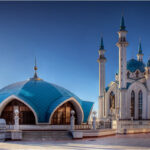The Requirements Of Women’s Hijaab In Accordance With The Qur’aan, The Authentic Sunnah, And The Practice Of The Pious Predecessors
Introduction:
This essay will attempt to briefly yet concisely enumerate the basic requirements regarding Muslim women’s dress (Hijaab) as stipulated by the Sharee’ah of Islaam. The term Hijaab, itself includes not only dress and covering the body, but methods of behaviour before members of the same and/or opposite sex, promoting privacy for females and prohibiting loose intermingling between males and females, thereby encouraging modesty, decency, and chastity.
Minor differences exist among the scholars regarding the actual number of requirements because of varying methods used by them in codifying such. The ones mentioned here represent the ones agreed upon by the overwhelming majority of scholars and are all solidly backed by firm evidence taken from the Quraan, the Sunnah and the practice of the Sahaabah (radiallahu ‘anhum).
The First Requirement Of Women’s Hijaab In Accordance With The Qur’aan, The Authentic Sunnah, And The Practice Of The Pious Predecessors: The Extent of Covering
The dress worn in public must cover the entire body except what has been specifically excluded, based upon the following proofs:
Allah Ta’ala says: And tell the believing women to lower their gaze and guard their private pans from sin and not show off their adornment (Zeenah) except only that which is apparent, and draw their headcovers (Khumur) over their necks and bosoms and not reveal their adornment except to their husbands, their fathers, their husbands’ fathers, their sons, their husbands’ sons, their brothers, or their brothers’ sons, or their sisters’ sons, or their women (i.e., their sisters in Islaam), or their female slaves whom their right hands possess, or old male servants free of physical desires, or small children who have no sense of women’s nakedness. And let them not stamp their feet so as to reveal what they hide of their adornment. And turn unto Allah all together, 0 you Believers, in order that you may attain success. [An-Noor: 31]
The word zeenah in the Aayah above, literally means ‘adornment’, and includes both (a) that which Allah has adorned, i.e., the woman’s natural and/or physical beauty, and (b) that with which they adorn themselves, i.e., jewelry, eye shadow, attractive clothing, hand dye, etc. Soorah An-Noor spells out specifically the commands concerning the fact that a woman’s natural beauty and her adornments are to be concealed from strangers except by: (1) What may show due to accidental or uncontrollable factors such as the blowing of the wind, etc., and (2) What has been exempted (see explanation at end of this section).
Allah also says: O Prophet, tell your wives and your daughters the women of the believers to draw their out garments (jalaabeeb) about themselves (when they go out). That is better so that they may be recognized and not molested. And Allah is Forgiving, Merciful. [Al-Ahzaab:59)
Abu Dawood narrates that ‘Aaishah (radiallahu ‘anhaa) said Asmaa’ the daughter of Abu Bakr (radiallahu ‘anhumaa) came to see the Messenger of Allah (sallallahu ‘alaihi wa sallam) wearing a thin dress; Rasool- Allah (sallallahu ‘alaihi wa sallam) turned away from her and said: 0 Asmaa’, once a woman reaches the age menstruation, no part of her body should be seen but this – and he pointed to his face and hands.
The word Khumur (p1. of Khimaar) refers to a cloth which covers the head (including the ears), hair, neck and bosom. The esteemed Mufassir (Quraanic interpreter) Al-Qurtubee explained: Women in the past used to cover their heads with Khimaar, throwing its ends over their backs. Thus leaving the neck and the upper part of the chest bare, in manner of the Christians. Then Allah commanded them to cover those parts with the Khimaar.
Allah states further in this Aayah: And let them not stamp their feet so as to reveal what they hide of their adornment…
The women in the time of the Prophet (sallallahu ‘alaihi wa sallam) wore anklets which could employed to attract attention by stamping their feet thereby making the anklets tinkle. This practice is not only forbidden by Allah, but moreover, shows that the legs and ankles are to be covered as well.
Some of modern day Hanafee scholars are of the mistaken view that a woman can display her feet, a portion of her forearms and her ears; yet there is no authentic proof from the practice of the Prophet (sallallahu ‘alaihi wa sallam) or Sahaabah to uphold such a view.
Amongst the authentic Ahadeeth which clarify this point is the following: lbn ‘Umar (radiallahu ‘anhu) reported that Rasoolullah (sallallahu ‘alaihi wa sallam) said: On the Day of Resurrection Allah will not look at the man who trails his garment along out of pride. Umm Salamah then asked: What should women do with (the hems of) her garment? He replied: Let them lower them a handspan. She said: Their feet would be exposed! He then said: Let them lower them a forearm’s length but no more. [Reported by At~Tabaraanee-Saheeh).
The Aayah of Soorah An-Noor also lists in detail those with whom a woman is permitted to be more at ease. Furthermore, the ayah from Soorah Al-Ahzaab orders Muslim women to draw their outer garments about themselves when they go out.
Abu Dawood related that ‘Aaishah (radiallahu ‘anhaa) said: After this Aayah was revealed the women of the Ansaar appeared like crows (because of the color and shape of the cloaks they wore). Hence, an outer garment or cloak must be worn by a Muslim woman whenever she goes out in public or if she is presence of strangers within her own home or the home of a close relative.
Slight differences have arisen among the scholars concerning the precise meaning of …except that which is apparent… from Soorah An-Noor which according to Ibn ‘Abbaas (radiallahu ‘anhu), includes ‘the face and the two hands, and rings.’ This view is shared by Ibn ‘Umar, ‘Ata’a, and others from the Tabi’een. [Tafseer Ibn Katheer] Also, Imaam Ash-Showkani states concerning this same ayaah, that it includes: “The dress, the face, and the two hands”; Ibn ‘Abbaas and Qataadah have stated “The adornments include eye shadow (Kuhul), bracelets, hand dye, and rings, and it is not permissable for women to (uncover) them.” [Fath Al-Qadeer]
The major point of difference among the scholars concerns the hadeeth of Asmaa (radiallahu ‘anhaa) i.e., that the face and hands need not be covered; a number of the scholars have maintained that the face and hands must also be covered, because it was the practice of the wives of the Prophet (sallallahu ‘alaihi wa sallam) and the wives of the Sahaabah to cover themselves completely according to authentic Ahadeeth. The above point has been a topic of debate amongst the scholars both past and present and will be dealt with, Insha’ Allah at the end of this essay.
The Second Requirement Of Women’s Hijaab In Accordance With The Qur’aan, The Authentic Sunnah, And The Practice Of The Pious Predecessors: Thickness
The garment should be thick and opaque so as not to display the skin color and form of the body beneath it. Delicate or transparent clothing does not constitute a proper covering. Al-Qurtubee reports a narration from ‘Aaishah (radiallahu ‘anhaa) that some women from Banu Tameem came to see her wearing transparent clothing. ‘Aaishah said to them: If you are believing women, these are not the clothes of believing women.
He also reports that a bride came to see her, wearing a sheer, transparent Khimaar whereupon ‘Aaishah (radiallahu ‘anhaa) said: A woman who wears such clothing does not believe in Soorat An-Noor. Moreover, the following hadeeth makes this point graphically clear. Rasool-Allah (sallallahu ‘alaihi wa sallam) said: There will be in the last of my Ummah, scantily dressed women, the hair on the top of their heads like a camel’s hump. Curse them, for verily they are cursed.
In another version he (sallallahu ‘alaihi wa sallam) said: …scantily dressed women, who go astray and make others go astray; they will not enter Paradise nor smell its fragrance, although it can be smelled from afar. [At-Tabaranee and Saheeh Muslim]
“Scantily dressed women” are those who wear clothing which reveals more than it conceals, thereby increasing her attractiveness while opening the path to a host of evils.
The Third Requirement Of Women’s Hijaab In Accordance With The Qur’aan, The Authentic Sunnah, And The Practice Of The Pious Predecessors: Looseness
The clothing must hang loosely enough and not be so tight-fitting as to show the shape and size of the woman’s body. This obviously includes such things as skin-tight body suits, etc. The following hadeeth proves this point clearly. Usaama ibn Zayd (radiallahu ‘anhumaa) said: Rasool-Allah (sallallahu ‘alaihi wa sallam) gave me a gift of thick Coptic cloth he had received as a gift from Dahiah Al-Kalbee, and so I gave it to my wife.
Thereafter the Prophet (sallallahu ‘alaihi wa sallam) asked me: Why didn’t you wear the Coptic cloth? I replied: I gave it to my wife. The Prophet (sallallahu ‘alaihi wa sallam) then said: Tell her to wear a thick gown under it (the Coptic garment) for I fear that it may describe the size of her limbs. [Narrated by Ahmad, AI-Bayhaqee, and Al-Haakim]
The Fourth Requirement Of Women’s Hijaab In Accordance With The Qur’aan, The Authentic Sunnah, And The Practice Of The Pious Predecessors: Color, Appearance and Demeanor
Allah Ta’ala says: 0 wives of the Prophet! You are not like any other women; if you fear (Allah), then do not he too pleasant of speech, lest one in whose heart is a disease should feel desire for you. [Al- Ahzaab: 32]
The reason for the revelation of this verse is not the fear of distrust nor misbehavior on the part of the women, but rather to prevent them from speaking invitingly, walking seductively, or dressing revealingly so as to arouse sexual desire in the heart of lecherous and evil men. Seductive dressing and enticing speech are the characteristics of ill-intentioned women, not Muslims. Al-Qurtubee mentions that Mujahid (radiallahu ‘anhu) said: Women (before the advent of Islaam) used to walk about among men. Qataada (radiallahu ‘anhu) said: They used to walk in a sensuous and seductive manner. Maqaatil (radiallahu ‘anhu) said: The women used to wear an untied cloth on their heads, while provocatively toying with their necklaces, earrings and other ornamental jewelry.
Furthermore, Allah has commanded women not to display their beauty, meaning both natural and acquired beauty.
Allah commands the believing women thus: …And do not make a display of yourselves (tabarruj) like the displaying of the ignorance of long ago… [Al-Ahzaab: 33]
A garment which is intended to conceal a woman and her beauty from public view cannot be a thing which enhances her beauty. Therefore, the garment cannot contain bright colors, bold designs or shiny and reflective material that draw men’s attention to the wearer. The word above, At-Tabarruj, means not only “to display oneself” but also “to spruce up one’s charms for the purpose of exciting desire”!
Imaam Adh-Dhahabee says in his book Kitaab AI-Kabaa’ir (The Book of Major Sins): Amongst the deeds which a woman is cursed for are displaying the adornments she wears, wearing perfume when she goes out, and wearing colorful clothes… Hence, the Muslim woman is encouraged to wear muted, somber colors and to avoid bright designs, patterns and colors.
This point should serve also as a reminder to Muslim men who are in positions of responsibility for their women, that Rasool-Allah (sallallahu ‘alaihi wa sallam) has warned in an authentic hadeeth narrated by ‘Abdullah ibn ‘Amr ibn Al-‘Aas that amongst the three individuals who would not enter Jannah (Paradise) would be: Ad-Dayooth, who is contented with obscenity within his family. i.e., a cuckold – a man who permits the women he is responsible for, such as his wife, daughter, etc. to engage in illicit sexual relations or to display their beauty to men, thereby stimulating sexual desire!
The Fifth Requirement Of Women’s Hijaab In Accordance With The Qur’aan, The Authentic Sunnah, And The Practice Of The Pious Predecessors: Difference from Men’s Clothing
The clothing of a Muslim woman must not resemble the clothing of men. The following two hadeeth help to explain this.
Abu Hurayrah (radiallahu ‘anhu) said: Rasool-Allah (sallallahu ‘alaihi wa sallam) cursed the man who wears women’s clothes and the woman who wears men’s clothes. [Abu Dawood and Ibn Maajah Saheeh]
‘Abdullah ibn ‘Umar (radiallahu ‘anhumaa) said he heard Rasool-Allah (sallallahu ‘alaihi wa sallam) say: The man who resembles a woman and the woman who resembles a man is not of us (i.e., not of the believers). [Ahmad and At-Tabaraanee – Saheeh)
Additionally, Abu Dawood relates a narration from Umm Salamah (radiallahu ‘anhaa) which shows that the Prophet (sallallahu ‘alaihi wa sallam) forbade women to bundle their Khumoor on their heads in such a way as to resemble the turban of a man. Western Muslim sisters should pay specific attention to this point since regretfully this has become a widespread practice amongst many of them!
The Sixth Requirement Of Women’s Hijaab In Accordance With The Qur’aan, The Authentic Sunnah, And The Practice Of The Pious Predecessors: Difference from the Clothing of Unbelievers
Her clothing must not resemble the clothing of unbelievers. This is a general ruling of the Sharee’ah which encompasses not only dress but also such things as manners, customs, religious practices and festivities, transactions, etc. Indeed, dissimilarity with unbelievers is a precedent that was established by the first generation of Islam. The following two hadeeth and statement of ‘Umar (radiallahu ‘anhu) will help to clarify this position.
‘Abdullah ibn ‘Amr ibn Al-‘Aas said: Rasool-Allah (sallallahu ‘alaihi wa sallam) saw me wearing two saffron colored garments, so he said: Indeed, these are the clothes of kuffaar (unbelievers), so do not wear them. [Saheeh Muslim]
‘Abdullah ibn ‘Umar (radiallahu ‘anhumaa) said: Rasool-Allah (sallallahu ‘alaihi wa sallam) stated: Whoever resembles a people is one of them. [Abu Daawood]
Abu Musa Al-Ash’aree (radiallahu ‘anhu) related that ‘Umar (radiallahu ‘anhu) told him: …I shall not honor those whom Allah has dishonored, nor esteem those He has humbled, nor bring close those whom He has kept afar. [Ahmad]
The Seventh Requirement Of Women’s Hijaab In Accordance With The Qur’aan, The Authentic Sunnah, And The Practice Of The Pious Predecessors: No Vain or Ostentatious Dressing
The woman’s dress must not be an expression of ostentation, vanity or as a status symbol by being excessively showy or expensive, nor must it be excessively tattered so as to gain admiration and fame for being humble. Ibn ‘Umar (radiallahu ‘anhumaa) reported that Rasool-Allah (sallallahu ‘alaihi wa sallam) said: Whoever dresses for ostentation in this world, Allah will dress that person in a dress of humiliation on the Day of Resurrection, and then set it on fire. [Abu Dawood]
Visits: 0




















